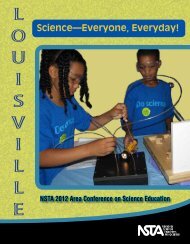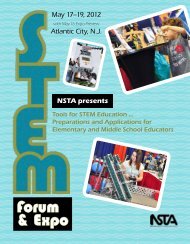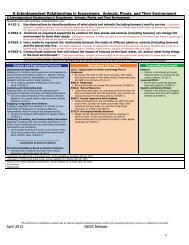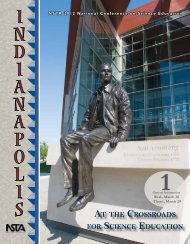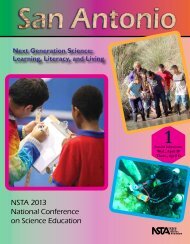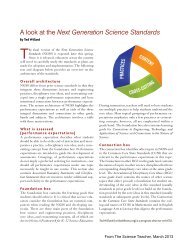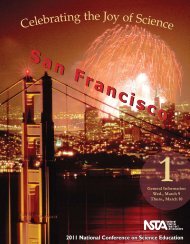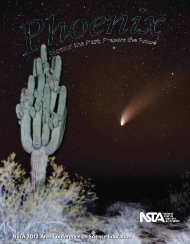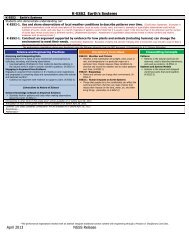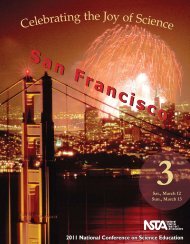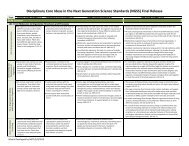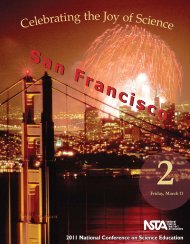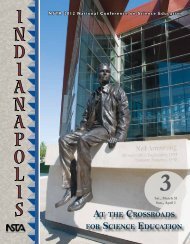Atlanta Conference Program
Atlanta Conference Program
Atlanta Conference Program
Create successful ePaper yourself
Turn your PDF publications into a flip-book with our unique Google optimized e-Paper software.
<strong>Conference</strong> <strong>Program</strong> • Special <strong>Program</strong>s<br />
Chemistry Day at NSTA<br />
Sponsored by the American Chemical Society<br />
Equilibrium, Le Chatelier, and Rate<br />
For Grades 9–12<br />
Friday, November 2, 8:00 AM–4:30 PM<br />
B303, GWCC<br />
Engage in activities, discussion, analyses, and assessment that<br />
help understanding of the relationships among equilibria, Le<br />
Chatelier’s principle, and rates and their roles in moving toward<br />
a more sustainable use of Earth’s resources.<br />
Education research indicates a positive correlation between<br />
teacher content knowledge and student learning. The goals of<br />
this workshop are to enhance and enrich secondary chemistry<br />
teachers’ knowledge of and interrelationships among equilibria,<br />
Le Chatelier, and rates through engagement in activities, discussion,<br />
and analyses that demonstrate how lessons on these concepts<br />
can be presented in a way that stimulates student thinking<br />
and prompts exploration of the complexity of the concepts as<br />
they relate to sustainability.<br />
The content and structure of the workshop draws on several<br />
decades of experience the American Chemical Society has in<br />
activity-based curricula development that include incorporation<br />
of sustainability and Green Chemistry principles. The workshop<br />
is a daylong series of lessons on equilibria, Le Chatelier’s principle,<br />
and rates—topics central to understanding the behavior<br />
of matter and chemical change. A complementary theme of the<br />
workshop is incorporating activities as part of the assessment of<br />
student learning.<br />
8:00–9:00 AM Equilibrium and Concentration<br />
(p. 70)<br />
9:30–10:30 AM Equilibrium and Energy (p. 77)<br />
11:00 AM–12 Noon Rate (p. 82)<br />
12:30–1:30 PM Catalysis (p. 88)<br />
2:00–3:00 PM Light as a Reactant and/or Product<br />
(p. 92)<br />
3:30–4:30 PM Half-Life (p. 97)<br />
Middle School Chemistry Day<br />
Sponsored by the American Chemical Society<br />
Middle School Chemistry—<br />
Big Ideas About the Very Small<br />
Friday, November 2, 8:00 AM–4:30 PM<br />
B302, GWCC<br />
Come to one, two, or as many sessions as you like during this<br />
full day of activities and information for teaching and learning<br />
middle school chemistry. Staff from the American Chemical<br />
Society will introduce participants to the new free online<br />
resource middleschoolchemistry.com. Each of the six sessions will<br />
include hands-on activities and explanations from the website<br />
that participants can easily incorporate into their teaching to<br />
support their current textbook and curriculum. Handouts of the<br />
session activities will be available for all participants.<br />
8:00–9:00 AM Solids, Liquids, and Gases: The<br />
Kinetic-molecular Theory of<br />
Matter (p. 70)<br />
9:30–10:30 AM Changes of State: Evaporation and<br />
Condensation (p. 76)<br />
11:00 AM–12 Noon Density: A Molecular View (p. 82)<br />
12:30–1:30 PM The Periodic Table, Energy Levels,<br />
and Bonding (p. 88)<br />
2:00–3:00 PM The Polarity of the Water Molecule<br />
and Its Consequences (p. 92)<br />
3:30–4:30 PM Chemical Change: Breaking and<br />
Making Bonds (p. 97)<br />
NSTA <strong>Atlanta</strong> Area <strong>Conference</strong> on Science Education<br />
29



